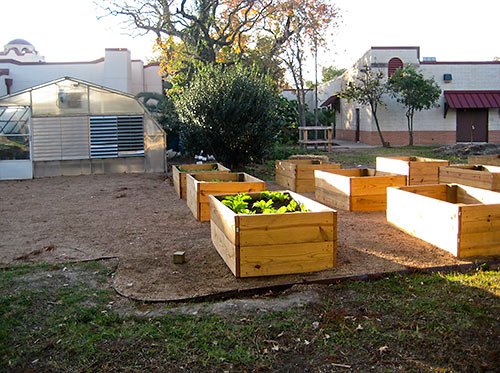
Cite magazine editor Raj Mankad leads readers on a brief photo tour of “one of the most mind-boggling sites in the Houston area.” Hills, in Pasadena! “Many of the slopes are planted with grass,” he writes. “On one visit several years ago, I saw a horse grazing at the base of one. If I squinted, I could imagine myself in Montana, if not the Alps.”
Better than a waiting-for-snow ski resort, though, these landforms north of Hwy. 225 inside Beltway 8 east of Red Bluff Rd. on the south side of the Houston Ship Channel are made of phosphogypsum. Phosphogypsum is a byproduct of the production of phosphate fertilizers, which took place on the site between 1960 and 2011, under the successive stewardship of a series of companies including ExxonMobil and Agrifos. Why was all this gypsum kept in mountainous piles instead of stuffed into wallboards or something? Well, the EPA doesn’t allow that if the material is too radioactive, which phosphogypsum generally is. So the glowy stuff has to be stored somewhere.
CONTINUE READING THIS STORY
There’s Glow in Them Thar Hills
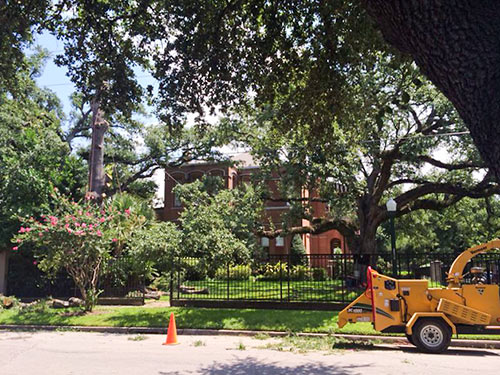
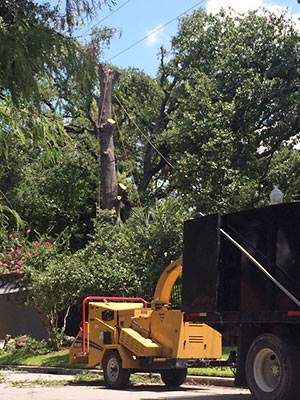 The Waldo Mansion at 201 Westmoreland St. in Westmoreland, best known (well, for its interiors at least) as the terrestrial stomping ground of playboy astronaut Garrett Breedlove, the Jack Nicholson character in Terms of Endearment, is getting a bit of a haircut today. Tree crews have been working all morning to start the process of ridding the site at the corner of Westmoreland and Garrott of “many” of its large surrounding oak trees, a reader tells Swamplot. But only a single tree has been removed so far, as these photos show.
The Waldo Mansion at 201 Westmoreland St. in Westmoreland, best known (well, for its interiors at least) as the terrestrial stomping ground of playboy astronaut Garrett Breedlove, the Jack Nicholson character in Terms of Endearment, is getting a bit of a haircut today. Tree crews have been working all morning to start the process of ridding the site at the corner of Westmoreland and Garrott of “many” of its large surrounding oak trees, a reader tells Swamplot. But only a single tree has been removed so far, as these photos show.

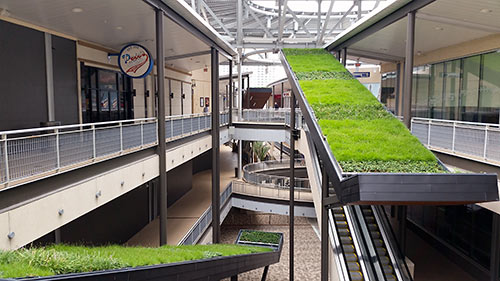

 “The definition of a ‘spring’ can vary a lot, and is used loosely here.
In Harris County, where the topography is relatively flat, most of our ‘ponds’ and ‘lakes’ are either borrow pits (excavated to raise the grade elsewhere) or dammed-up gullies/ravines along existing bayous. In this case, it is the latter — a gully of Buffalo Bayou that was dammed up, then developed into a neighborhood.
A ‘spring’ is generally a point where the top groundwater table meets the surface. In our area, when we receive a lot of rain, the groundwater table can actually reach the surface. So a spring can range from a trickle of water to a puddle standing on the surface. When I dug the post holes in my backyard for my cedar fence, I hit groundwater at 2 feet deep because of recent heavy rain. In dryer periods, the water table drops, and springs continue to occur along steep cuts in the topography (either along a bayou that has eroded downward, or a man-made excavation). This is not what you find in the Hill Country, where large gaping holes in limestone spew thousands of gallons per hour, sometimes creating rivers out of nothing.
So effectively, any hole in Houston greater than 2 feet deep at some point will become ‘spring-fed.’ During the bad drought of the past few years, most likely the groundwater table dropped and stopped feeding this former gully of the bayou, and the ‘lake’ was most likely topped off by (1) automatic sprinkler runoff and (2) the small amount of storm water runoff they received, as the lake also serves as the neighborhood drainage ditch.” [
“The definition of a ‘spring’ can vary a lot, and is used loosely here.
In Harris County, where the topography is relatively flat, most of our ‘ponds’ and ‘lakes’ are either borrow pits (excavated to raise the grade elsewhere) or dammed-up gullies/ravines along existing bayous. In this case, it is the latter — a gully of Buffalo Bayou that was dammed up, then developed into a neighborhood.
A ‘spring’ is generally a point where the top groundwater table meets the surface. In our area, when we receive a lot of rain, the groundwater table can actually reach the surface. So a spring can range from a trickle of water to a puddle standing on the surface. When I dug the post holes in my backyard for my cedar fence, I hit groundwater at 2 feet deep because of recent heavy rain. In dryer periods, the water table drops, and springs continue to occur along steep cuts in the topography (either along a bayou that has eroded downward, or a man-made excavation). This is not what you find in the Hill Country, where large gaping holes in limestone spew thousands of gallons per hour, sometimes creating rivers out of nothing.
So effectively, any hole in Houston greater than 2 feet deep at some point will become ‘spring-fed.’ During the bad drought of the past few years, most likely the groundwater table dropped and stopped feeding this former gully of the bayou, and the ‘lake’ was most likely topped off by (1) automatic sprinkler runoff and (2) the small amount of storm water runoff they received, as the lake also serves as the neighborhood drainage ditch.” [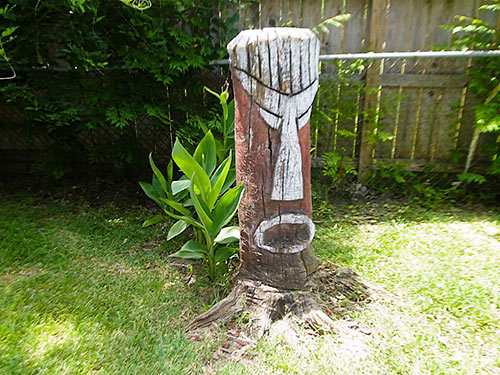
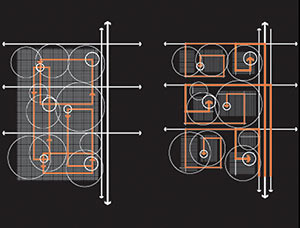 “In the 1950s just about the entire world abandoned continuous block and street urbanism and switched over to spine-based urbanism. We moved from a metropolitan to a megalopolitan type of urbanism and to really get that you have to know the distinction between the two terms. On some level, we all know that when we go outside the Loop that we have moved into a different world, a different reality.
“In the 1950s just about the entire world abandoned continuous block and street urbanism and switched over to spine-based urbanism. We moved from a metropolitan to a megalopolitan type of urbanism and to really get that you have to know the distinction between the two terms. On some level, we all know that when we go outside the Loop that we have moved into a different world, a different reality. 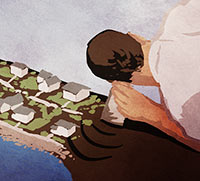 “As someone who used to work on seismic crews for years before moving into designing these subsurface programs, I can tell you all about these. Vibe machines shake the ground using varying frequencies, some you feel, many you can’t. Those waves penetrate the earth with some of the energy reflecting back to the surface when it hits a density change while some of the energy refracts deeper down. Geophones are placed in an array at set spacing surrounding the source (vibe) and ‘listen’ for these reflected waves to return and record the strength and timing of the returning wave.
So, as previously mentioned, this is an oil/gas survey not ‘minerals,’ although the subsurface rights are called ‘mineral rights.’
Mineral rights supercede those of surface rights. You absolutely can shoot seismic on someones land without their permission. It sets up bad rapport and ultimately it’s not the seismic company that makes that decision, it’s the oil/gas company that is hiring them to do so. It usually only has to happen on large tracts. Small ones, you can navigate around the refusal without compromising data integrity. Large tracts you have to get a TRO (temporary restraining order) and usually the local sheriff is brought in to ensure security. It was rare, but it did happen. Aside from bad blood between the landowner and the field crew, we would generally find some of our equipment damaged upon removal.” [
“As someone who used to work on seismic crews for years before moving into designing these subsurface programs, I can tell you all about these. Vibe machines shake the ground using varying frequencies, some you feel, many you can’t. Those waves penetrate the earth with some of the energy reflecting back to the surface when it hits a density change while some of the energy refracts deeper down. Geophones are placed in an array at set spacing surrounding the source (vibe) and ‘listen’ for these reflected waves to return and record the strength and timing of the returning wave.
So, as previously mentioned, this is an oil/gas survey not ‘minerals,’ although the subsurface rights are called ‘mineral rights.’
Mineral rights supercede those of surface rights. You absolutely can shoot seismic on someones land without their permission. It sets up bad rapport and ultimately it’s not the seismic company that makes that decision, it’s the oil/gas company that is hiring them to do so. It usually only has to happen on large tracts. Small ones, you can navigate around the refusal without compromising data integrity. Large tracts you have to get a TRO (temporary restraining order) and usually the local sheriff is brought in to ensure security. It was rare, but it did happen. Aside from bad blood between the landowner and the field crew, we would generally find some of our equipment damaged upon removal.” [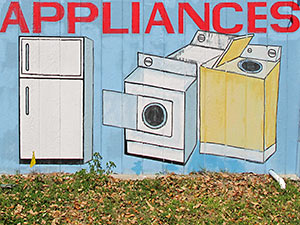 Spring has sprung, notes local film curator Peter Lucas. And that means a fresh crop of hand-painted signs has already sprouted: “Each spring — that all-too-brief time when the sun starts to shine in a few bright spurts but hasn’t yet begun to make being outdoors nearly unbearable and opening our eyes wide nearly impossible — this town begins to reveal an exhibition rivaling those in any of our art galleries and museums. Colors pop against each other. Structures pierce the blue sky. Degraded materials reveal complex textures. Drop-shadows create depth interplay with architectural flourishes and telephone lines.
Spring has sprung, notes local film curator Peter Lucas. And that means a fresh crop of hand-painted signs has already sprouted: “Each spring — that all-too-brief time when the sun starts to shine in a few bright spurts but hasn’t yet begun to make being outdoors nearly unbearable and opening our eyes wide nearly impossible — this town begins to reveal an exhibition rivaling those in any of our art galleries and museums. Colors pop against each other. Structures pierce the blue sky. Degraded materials reveal complex textures. Drop-shadows create depth interplay with architectural flourishes and telephone lines. 
 “A subway WILL work in Houston, albeit at a significantly higher cost. I’m a civil engineer who builds tunnels, nationwide. They’re not even significantly more expensive in Houston than elsewhere. Tunnels in LA, NY, Chicago, Montreal, London etc all have to deal with bedrock — which is very expensive to tunnel through. Instead, Houston uses open-cut excavation and massive soil amendments + ground water pumping to tunnel. For example — the depressed portions of US-59 from Shepherd to Montrose (or the depressed portion of Beltway 8 from Boheme to I-10) are essentially a tunnel with no roof because they’re lower than the bayou and the ground water table; it took expensive soil amendments and pumps to build that, the same as a subway. Our commuter rail tunnel projects in LA are bidding for between $18M-$20M per mile of track, while the at-grade portions are only about $4M per mile. We consistently find that tunnels cost about 4x-5x as much as at-grade track. Meanwhile, elevated track costs roughly $25M a mile (6x at-grade costs). . . .” [
“A subway WILL work in Houston, albeit at a significantly higher cost. I’m a civil engineer who builds tunnels, nationwide. They’re not even significantly more expensive in Houston than elsewhere. Tunnels in LA, NY, Chicago, Montreal, London etc all have to deal with bedrock — which is very expensive to tunnel through. Instead, Houston uses open-cut excavation and massive soil amendments + ground water pumping to tunnel. For example — the depressed portions of US-59 from Shepherd to Montrose (or the depressed portion of Beltway 8 from Boheme to I-10) are essentially a tunnel with no roof because they’re lower than the bayou and the ground water table; it took expensive soil amendments and pumps to build that, the same as a subway. Our commuter rail tunnel projects in LA are bidding for between $18M-$20M per mile of track, while the at-grade portions are only about $4M per mile. We consistently find that tunnels cost about 4x-5x as much as at-grade track. Meanwhile, elevated track costs roughly $25M a mile (6x at-grade costs). . . .” [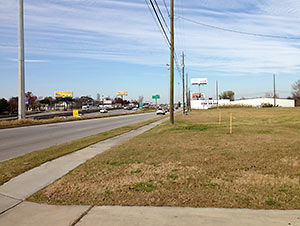 Reader Joel Balderas seeks some Brooke Smith-area feeder road intel: “I’m curious what’s going on at the property located at approximately 2450 North Freeway. I live just around the corner and I noticed that a couple weeks ago the for sale sign was taken down and stakes were placed around the property with pink flags. The lot looks to be about an acre and a half and sits on the northbound side of I-45 between North Main and Patton. I-45 bounds it to the west. Little White Oak and Top Brass are to the north. A small home is to the south at 2406 North Freeway. To the east is a wooded area that would double the size of the lot. After the wooded area you would hit Little White Oak again. On the north east corner is a T-Mobile tower and on the south west corner is a large billboard facing north, which is currently advertising Fiesta. If you hear of anything I’d appreciate the info.” Photo: Joel Balderas
Reader Joel Balderas seeks some Brooke Smith-area feeder road intel: “I’m curious what’s going on at the property located at approximately 2450 North Freeway. I live just around the corner and I noticed that a couple weeks ago the for sale sign was taken down and stakes were placed around the property with pink flags. The lot looks to be about an acre and a half and sits on the northbound side of I-45 between North Main and Patton. I-45 bounds it to the west. Little White Oak and Top Brass are to the north. A small home is to the south at 2406 North Freeway. To the east is a wooded area that would double the size of the lot. After the wooded area you would hit Little White Oak again. On the north east corner is a T-Mobile tower and on the south west corner is a large billboard facing north, which is currently advertising Fiesta. If you hear of anything I’d appreciate the info.” Photo: Joel Balderas